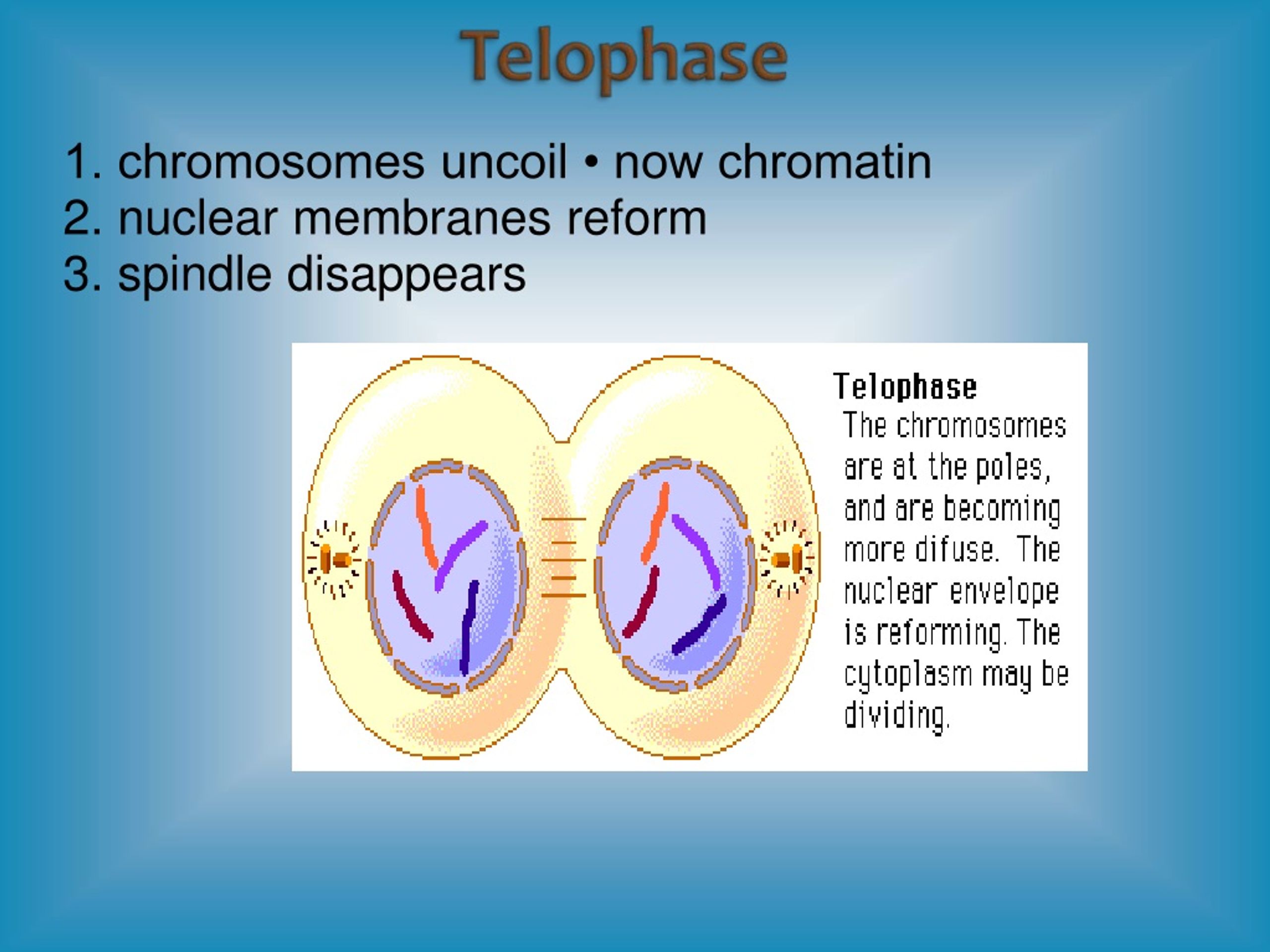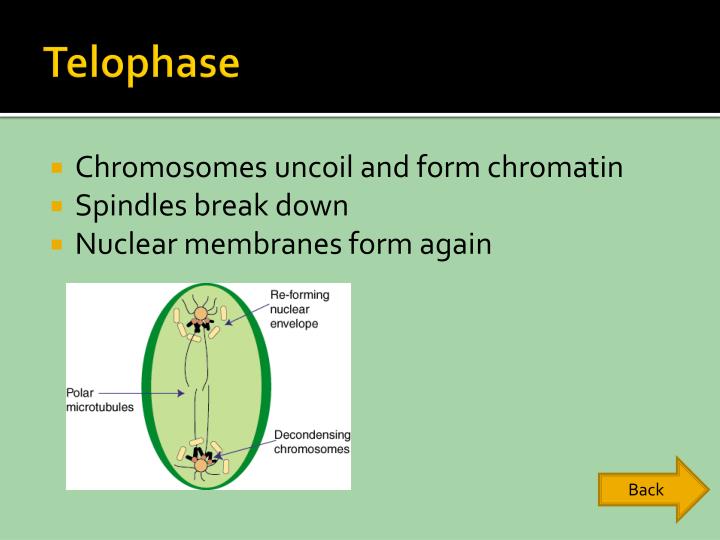Chromosomes Uncoil To Form Chromatin
Chromosomes Uncoil To Form Chromatin - Web telophase chromosomes uncoil to form chromatin. The nucleosome is further folded to produce a chromatin fiber. Chromosomes align on the spindle equator. Spindle fibers break downward, nuclear membrane application, and chromosomes getting to uncoil and application chromatin. Chromosomal centromeres split and chromosomes migrate to opposite ends metaphase of the cell. Dna, histones, and chromatin the answer to this question lies in the fact that certain proteins compact chromosomal dna into the microscopic space of the eukaryotic nucleus. The genetic contents of one cell have been divided. There are six phases with mitosis and telophase is number four. Distinct chromosomes are often not visible and nuclear membranes may be present. Web at the telophase of meiotic and mitotic cell divisions, the chromosomes of daughter cells uncoil back to chromatin, but after interphase, it coils up again to form visible chromosomes.
After these changes, telophase/mitosis is largely complete. Nuclear membrane and nucleolus disintegrate. Isn't it simpler and more convenient for the chromosomes of the cells coil up in 1 cell cycle? **cell looks like its being pinched. Chromosomal centromeres split and chromosomes migrate to opposite ends metaphase of the cell. Chromatin fibers are coiled and condensed to form chromosomes. Web how is this possible? Chromosomes uncoil to form chromatin. Web each of us has enough dna to reach from here to of daylight and back, get than 300 times. During the telophase phase, the chromosomes begin to uncoil.
Web how is this possible? Nuclear membrane and nucleolus disintegrate. The nucleosome is further folded to produce a chromatin fiber. Web at the telophase of meiotic and mitotic cell divisions, the chromosomes of daughter cells uncoil back to chromatin, but after interphase, it coils up again to form visible chromosomes. Spindle fibers break downward, nuclear membrane application, and chromosomes getting to uncoil and application chromatin. Chromosomes uncoil to form chromatin a.) early prophase b.) telophase c.) anaphase d.) metaphase e.) late prophase Web a nucleosome consists of a dna sequence of about 150 base pairs that is wrapped around a set of eight histones called an octamer. Chromosomal centromeres split and chromosomes migrate to opposite ends of the cell. After these changes, telophase/mitosis is largely complete. **cell looks like its being pinched.
Chromosomes and chromatin YouTube
Web how is this possible? Centrioles move to opposite ends of the cell. Spindle fibers break downward, nuclear membrane application, and chromosomes getting to uncoil and application chromatin. Dna, histones, and chromatin the answer to this question lies in the fact that certain proteins compact chromosomal dna into the microscopic space of the eukaryotic nucleus. The nucleosome is further folded.
PPT Lesson Objectives—Cell Cycle PowerPoint Presentation, free
Chromosomes uncoil to form chromatin. Chromosomal centromeres split and chromosomes migrate to opposite ends metaphase of the cell. Spindle fibers break downward, nuclear membrane application, and chromosomes getting to uncoil and application chromatin. Web at the telophase of meiotic and mitotic cell divisions, the chromosomes of daughter cells uncoil back to chromatin, but after interphase, it coils up again to.
chromosomes chromatin Google Search med Pinterest
Chromosomal centromeres split and chromosomes migrate to opposite ends of the cell. Chromosomes align on the spindle equator. How is all of this dna packaged so tightly into chromsomes and squeezed into a tiny nucleus? Chromosomes uncoil to form chromatin. Web the nuclear envelopes of these nuclei form from remnant pieces of the parent cell's nuclear envelope and from pieces.
Biologia i geologia de 4rt U1 Compactació del DNA
Dna, histones, and chromatin the answer to this question lies in the fact that certain proteins compact chromosomal dna into the microscopic space of the eukaryotic nucleus. Web telophase chromosomes uncoil to form chromatin. Chromosomes uncoil to form chromatin. Web the nuclear envelopes of these nuclei form from remnant pieces of the parent cell's nuclear envelope and from pieces of.
modifications of chromatin structure. Chromosomes are
After these changes, telophase/mitosis is largely complete. Nuclear membrane and nucleolus disintegrate. Distinct chromosomes are often not visible and nuclear membranes may be present. Chromatin fibers are coiled and condensed to form chromosomes. Web how is this possible?
Epigenomics approach illuminates the dark corners of the genome Broad
During the telophase phase, the chromosomes begin to uncoil. Nuclear membrane and nucleolus disintegrate 4 chromosomes align on the spindle equator centrioles move to opposite ends of the cell. Spindle fibers break downward, nuclear membrane application, and chromosomes getting to uncoil and application chromatin. Chromatin fibers are coiled and condensed to form chromosomes. Chromosomes uncoil to form chromatin a.) early.
Solved Drag the terms on the left to the appropriate blanks
Web telophase chromosomes uncoil to form chromatin. Chromosomal centromeres split and chromosomes migrate to opposite ends metaphase of the cell. Chromatin fibers are coiled and condensed to form chromosomes. The nucleosome is further folded to produce a chromatin fiber. Web each of us has enough dna to reach from here to of daylight and back, get than 300 times.
PPT Stages of Mitosis PowerPoint Presentation ID4828392
How is all of this dna packaged so tightly into chromsomes and squeezed into a tiny nucleus? Chromatin fibers of chromosomes uncoil. Web the nuclear envelopes of these nuclei form from remnant pieces of the parent cell's nuclear envelope and from pieces of the endomembrane system. Chromosomes uncoil to form chromatin a.) early prophase b.) telophase c.) anaphase d.) metaphase.
Mechanisms in Psychiatric Disorders
Chromosomes uncoil to form chromatin a.) early prophase b.) telophase c.) anaphase d.) metaphase e.) late prophase The genetic contents of one cell have been divided. Distinct chromosomes are often not visible and nuclear membranes may be present. Chromosomes uncoil to form chromatin. Web the nuclear envelopes of these nuclei form from remnant pieces of the parent cell's nuclear envelope.
Cell division, type of cell division, stages of nuclear division and
Centrioles move to opposite ends of the cell. Chromosomal centromeres split and chromosomes migrate to opposite ends metaphase of the cell. Nuclear membrane and nucleolus disintegrate. Chromosomes uncoil to form chromatin. How is all of this dna packaged so tightly into chromsomes and squeezed into a tiny nucleus?
Web At The Telophase Of Meiotic And Mitotic Cell Divisions, The Chromosomes Of Daughter Cells Uncoil Back To Chromatin, But After Interphase, It Coils Up Again To Form Visible Chromosomes.
Chromosomal centromeres split and chromosomes migrate to opposite ends of the cell. Web terms in this set (90) 1. Chromosomes align on the spindle equator. Dna, histones, and chromatin the answer to this question lies in the fact that certain proteins compact chromosomal dna into the microscopic space of the eukaryotic nucleus.
Nuclear Membrane And Nucleolus Disintegrate.
Web how is this possible? Chromosomes uncoil to form chromatin a.) early prophase b.) telophase c.) anaphase d.) metaphase e.) late prophase Chromatin fibers are coiled and condensed to form chromosomes. There are six phases with mitosis and telophase is number four.
Nuclear Membrane And Nucleolus Disintegrate 4 Chromosomes Align On The Spindle Equator Centrioles Move To Opposite Ends Of The Cell.
Web the nuclear envelopes of these nuclei form from remnant pieces of the parent cell's nuclear envelope and from pieces of the endomembrane system. Chromosomes uncoil to form chromatin. Isn't it simpler and more convenient for the chromosomes of the cells coil up in 1 cell cycle? Centrioles move to opposite ends of the cell.
Distinct Chromosomes Are Often Not Visible And Nuclear Membranes May Be Present.
How is all of this dna packaged so tightly into chromsomes and squeezed into a tiny nucleus? **cell looks like its being pinched. Spindle fibers break downward, nuclear membrane application, and chromosomes getting to uncoil and application chromatin. During the telophase phase, the chromosomes begin to uncoil.









